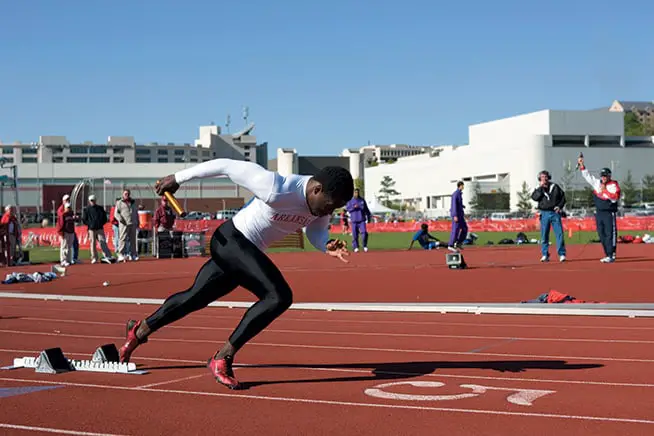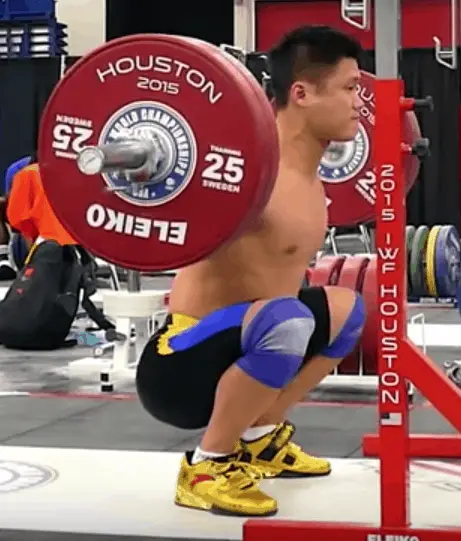
Speed is a vitally important skill on the rugby league field. If you are fast you can more easily break and evade tackles, make try saving tackles and gallop untouched down the sideline enroute to a game winning try. Of course it is no wonder that many aspiring rugby league players are looking for ways to increase their sprint speed. Is this possible or do you have to accept the pace that God blessed you with?
How to improve speed for rugby league?
To improve your speed for rugby league you can decrease your body weight, particularly your body fat. You can improve your running technique, notably stride length and increase your leg strength in the gym by focusing on squats and deadlifts.
Will Losing Weight Increase My Speed For Rugby?
Losing weight and bodyfat will make you faster. The average sprinter is 6ft tall and weighs 80kg with a body fat of 8%-10%. If your body fat is above 10% your speed on the rugby pitch will improve significantly by dropping extra weight.

There is a reason you don’t see any fat sprinters at the Olympics because that extra blubber weighs you down, reducing your speed. Unless you are ripped with all your muscles visible then your sprint ability will be enhanced by dropping excess body fat.
The top sprinters have an average body fat in the 8%-10% range while the average rugby player is around the 14%-15% mark. If you can get closer to the 10% mark you will see your sprint times reduce substantially and you will be running down the sideline scoring more and more untouched tries.
To drop that extra bodyweight you need to establish a calorie deficit. This can be a bit tricky because if your deficit is too big you will lose muscle and your fat loss will quickly stall as your body goes into starvation mode. To ensure that doesn’t happen make sure you are consuming a high protein intake (1gram per pound of bodyweight daily, 200 pound athlete = 200grams of protein) and start off with a small calories deficit of 300 and only increase this deficit if your weight loss stalls.
To find out the amount calories you need to consume to lose weight you can use an online calculator which takes into account your height, weight and activity level. These are not the most accurate but they can give you a ballpark figure which you can play around with until you find out the right amount of calories you need to consume.
How To Improve My Running Technique For Rugby?
To improve your running technique on the rugby pitch you need to increase your stride length so you can cover more distance, relax your body as stiffness can lead to a loss of power and engage your arms properly, trying to reach the sky with your elbows is a common cue.

Many rugby players are convinced you are either born fast or slow and there is nothing you can do about it. This may be partially true as you are never going to win the 100m Olympic final without some high quality speedy genetics that doesn’t mean you can not greatly improve your speed with working on your running technique.
If genetics were the only thing that mattered when it came to speed then sprinters would just sit on the couch yearlong and not be training their asses off everyday.
There are many ways to develop your running technique. Here are a few things to work that will drop your sprint time quickly.
You most likely are not using your arms properly when you are sprinting. Your arms play a much bigger role in your speed than you think. Sprinters don’t have big arms for show they actually use them. Your arms will propel your body forward and lead the rest of your body when you are going on a lengthy line break.
To use your arms effectively you should incorporate Carl Lewis’ famed cue, “elbow to the sky, thumb to the eye”.
Another tip to help you improve your speed during a rugby match is to stay relaxed. Many players think they have to tense their whole body when sprinting but this only leads to a waste of energy and loss of power. When you are sprinting, stay relaxed and allow your body to move fluidly. You will be surprised at some of the sprint times you are capable of.
Posture plays a big role in how fast you are. A poor posture can slow down even the fastest rugby player. It is common for rugby players to lean too far forwards which hurts their balance and their power. To run with good posture keep your back straight, head neutral with your spine, a slight forward tilt in your hips and look straight ahead.
Speed may be partly genetic but by developing your running technique and mechanics you will be able to increase your speed substantially, allowing you to make more line breaks and score more tries.
Will Squats Increase My Speed For Rugby?
Squats will increase your leg strength which will increase speed. Other leg focused strength exercises such as standing barbell jumps, Olympic lifts and deadlifts will increase your sprinting ability.

Comfort el al. (2012) studied a squad of professional rugby league players to determine if increases in squat performance resulted in increased sprint speeds. They found that on average players increased their squat from 170kg to 200kg which coincided with a 7.6% increase in sprint speed over 5m, 7.3% increase over 10m and 5.9% increase over 20m.
This study clearly demonstrates that leg strength is a very important factor in speed and that squatting is an effective training method to increase leg strength and speed. Squatting appears to be particularly effective in developing initial acceleration from the sprinting starting position as the players’ squat improvements affected 5m sprint speed the most and 20m speed the least.
Squats aren’t the only form of strength training that improve your speed. Sáez de Villarreal et al. (2012) performed a meta analysis of all literature that explored the relationship between plyometrics and sprint performance and found that plyometric training did significantly increase athletes’ speed. On average plyometric training reduced 40m sprint times by 0.12 seconds, 30m times by 0.07 seconds and 20m times by 0.06 seconds.
Sáez de Villarreal et al. (2012) concluded the most effective plyometric program for rugby players to increase their speed would be a 8-10 week program with at least a total of 15 sessions featuring more than 80 combined jumps per session. A variety of different plyometric exercises should be utilised with a focus on horizontal acceleration.
Check Out World Champion Shot Putter Werner Gunthor Doing Plyometrics
Conclusion
If you haven’t been blessed with Usain Bolt speed do not give up hope. There is still a chance you can develop blistering speed on the rugby league pitch. To develop your speed you need to drop fat and aim to reach 10% body fat. You need work on your running technique, particularly posture, arm movement and stride length. You need to develop your leg strength through a combination of weight training focusing on squats and plyometric jumping training.